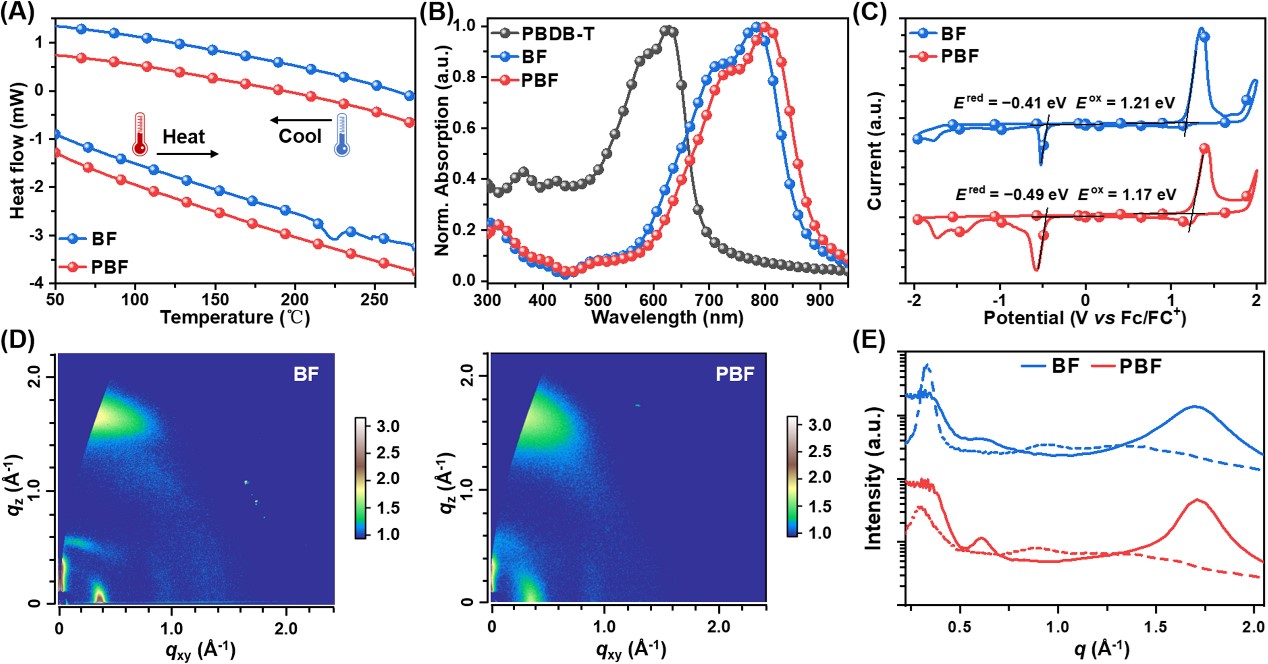As one of the very promising next-generation clean energy technologies, organic solar cells have many advantages such as low cost, light weight, flexibility, and easy large-area preparation. Broad application prospects. In recent years, thanks to the in-depth understanding of molecular design and device engineering, the photoelectric conversion efficiency of organic solar cells has exceeded 19%, which has aroused widespread interest including academia and industry. However, realizing the "golden triangle" (i.e., the efficiency-stability-cost balance) required for the commercial application of organic solar cells remains a formidable challenge.
The "Golden Triangle" of commercialization can be divided into two key parts: (1) how to balance efficiency and stability; (2) how to balance efficiency and cost. In 2017, Academician Li Yongfang's team proposed the concept of "polymerization of small molecule acceptors", which overcomes the problems of wide band gap and low absorption coefficient of traditional polymer acceptors, and makes all-polymer solar cells with excellent thermal/morphological stability The rapid increase in photoelectric conversion efficiency to over 18% paves the way for organic solar cells with a balanced efficiency-stability. However, polymer acceptors constructed with high-performance fused-ring electron acceptors as polymerized monomers also face the problems of complex monomer synthesis and high cost while achieving high efficiency. In recent years, non-fused-ring electron acceptors (NFREAs) with simple conjugated backbones, facile synthetic routes, and low cost have attracted much attention, especially by introducing intramolecular non-covalent "conformational locks" (NoCLs) or large steric hindrances. The group restricts the rotation of single bonds in the non-fused ring skeleton to construct highly planar and high-efficiency acceptor materials, and the energy conversion efficiency has exceeded 16%. Therefore, non-fused-ring electron acceptors are considered to be excellent candidates to achieve the efficiency-cost balance.
Recently, based on low-cost non-fused-ring electron acceptors, the research group proposed the design idea of "poly-non-fused-ring electron acceptors (PNFREAs)" (Sci. China Chem., 2022, 65, 926), which combines high The advantages of stable polymers and low-cost acceptor materials are expected to achieve the efficiency-stability-cost balance of organic solar cells. At present, researchers at home and abroad have made some efforts on the molecular design and device engineering of polynon-fused ring electron acceptors, but their photoelectric conversion efficiency still needs to be further improved to better balance the "golden triangle" of commercialization of organic solar cells. "

Figure 1. Schematic diagram of the evolution of acceptor materials proposed in this work to achieve the efficiency-stability-cost balance organic solar cells.
In this work, the author designed a new poly non-fused ring acceptor material PBF, and made a systematic comparison with the corresponding small molecule acceptor BF in terms of thermal stability, photovoltaic performance and industrial figure of merit (i-FOM). . In contrast, PBF has a higher thermal decomposition temperature, and DSC analysis shows that BF has an endothermic peak at 224 °C. At the same time, in the range of 50-250 °C, no obvious thermal transition signal was observed in the polymer acceptor PBF, indicating that PBF has better thermal stability. Second, PBFs also exhibit stronger light-harvesting ability and tighter intermolecular π–π stacking, which will benefit sunlight harvesting and facilitate charge transport in photovoltaic devices.

Figure 2. (E) Corresponding 1D line cutting diagram (solid line: out-of-plane direction, dotted line: in-plane direction)
The author further used PBDB-T as a donor, which was blended with two acceptor materials to prepare organic photovoltaic devices. The PBDB-T:BF-based device obtained a photoelectric conversion efficiency of 11.19%, while the PBDB-T:PBF all-polymer solar cell device showed a significantly improved efficiency (12.61%), creating a novel electron acceptor based on poly-non-condensed rings. highest efficiency of bulk organic solar cells. In addition, the authors also investigated the device stability of BF- and PBF-based organic solar cells. Significant efficiency decay (decayed to 63.4% of initial efficiency after 800 h) was observed in devices based on small molecule acceptor BF, while all-polymer solar cells based on polymer acceptor PBF exhibited excellent device stability ( Only decayed to 95.2% of initial efficiency after 800 hours).

Figure 3. (A) J-V curve; (B) EQE curve; (C) device stability.
In order to further evaluate the industrialization potential of organic solar cells, the author conducted a matrix analysis of the industrialization figure of merit (i-FOM) based on the "golden triangle" of efficiency-stability-cost. The i -FOM value. The results show that fused-ring electron acceptors and their polymeric derivatives are plagued by high cost issues, while non-fused-ring electron acceptors and their polymeric derivatives, which have the advantages of simple structures and facile synthesis, exhibit lower synthetic complexity . It is worth noting that the high-efficiency (12.61%), stable (95.2%) and low-cost (SCAL = 38.9) polymer-acceptor PBF blend system developed in this work achieved an i-FOM value of 0.309, which is much higher than that of PM6: Representative systems such as Y6 (i-FOM = 0.192) and PBDB-T:PZ1 (i-FOM = 0.167).

Figure 4. (A) Synthetic complexity analysis; (B) Efficiency-stability-cost analysis; (C) Relationship between industrial quality factor and synthetic complexity of representative systems.
This work provides new insights into the efficiency-stability-cost balance of organic solar cells, and also indicates that the development of polynon-fused ring electron acceptors will further promote the commercial application of organic solar cells.
The above research paper was published in the journal Aggregate with the title "Insight into the efficiency-stability-cost balanced organic solar cell based on a polymerized nonfused-ring electron acceptor". The author is Wei Yanan, a postdoctoral fellow, and the corresponding authors are Professor Huang Hui and Associate Professor Zhang Xin from the University of Chinese Academy of Sciences.
